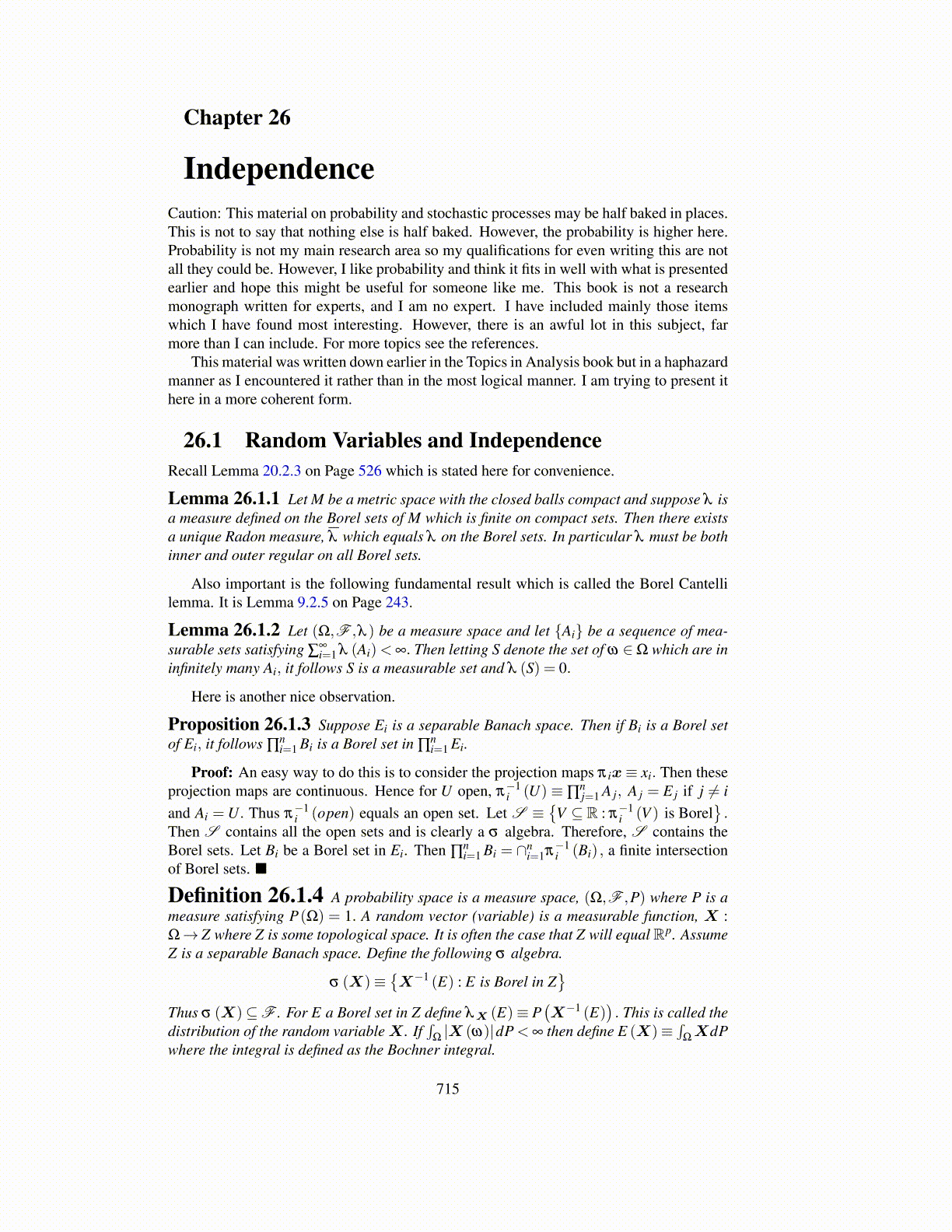
Chapter 26
IndependenceCaution: This material on probability and stochastic processes may be half baked in places.This is not to say that nothing else is half baked. However, the probability is higher here.Probability is not my main research area so my qualifications for even writing this are notall they could be. However, I like probability and think it fits in well with what is presentedearlier and hope this might be useful for someone like me. This book is not a researchmonograph written for experts, and I am no expert. I have included mainly those itemswhich I have found most interesting. However, there is an awful lot in this subject, farmore than I can include. For more topics see the references.
This material was written down earlier in the Topics in Analysis book but in a haphazardmanner as I encountered it rather than in the most logical manner. I am trying to present ithere in a more coherent form.
26.1 Random Variables and IndependenceRecall Lemma 20.2.3 on Page 526 which is stated here for convenience.
Lemma 26.1.1 Let M be a metric space with the closed balls compact and suppose λ isa measure defined on the Borel sets of M which is finite on compact sets. Then there existsa unique Radon measure, λ which equals λ on the Borel sets. In particular λ must be bothinner and outer regular on all Borel sets.
Also important is the following fundamental result which is called the Borel Cantellilemma. It is Lemma 9.2.5 on Page 243.
Lemma 26.1.2 Let (Ω,F ,λ ) be a measure space and let {Ai} be a sequence of mea-surable sets satisfying ∑
∞i=1 λ (Ai)< ∞. Then letting S denote the set of ω ∈Ω which are in
infinitely many Ai, it follows S is a measurable set and λ (S) = 0.
Here is another nice observation.
Proposition 26.1.3 Suppose Ei is a separable Banach space. Then if Bi is a Borel setof Ei, it follows ∏
ni=1 Bi is a Borel set in ∏
ni=1 Ei.
Proof: An easy way to do this is to consider the projection maps π ix≡ xi. Then theseprojection maps are continuous. Hence for U open, π
−1i (U) ≡∏
nj=1 A j, A j = E j if j ̸= i
and Ai = U. Thus π−1i (open) equals an open set. Let S ≡
{V ⊆ R : π
−1i (V ) is Borel
}.
Then S contains all the open sets and is clearly a σ algebra. Therefore, S contains theBorel sets. Let Bi be a Borel set in Ei. Then ∏
ni=1 Bi = ∩n
i=1π−1i (Bi) , a finite intersection
of Borel sets. ■
Definition 26.1.4 A probability space is a measure space, (Ω,F ,P) where P is ameasure satisfying P(Ω) = 1. A random vector (variable) is a measurable function, X :Ω→ Z where Z is some topological space. It is often the case that Z will equal Rp. AssumeZ is a separable Banach space. Define the following σ algebra.
σ (X)≡{X−1 (E) : E is Borel in Z
}Thus σ (X)⊆F . For E a Borel set in Z define λX (E)≡ P
(X−1 (E)
). This is called the
distribution of the random variableX . If∫
Ω|X (ω)|dP < ∞ then define E (X)≡
∫ΩXdP
where the integral is defined as the Bochner integral.
715